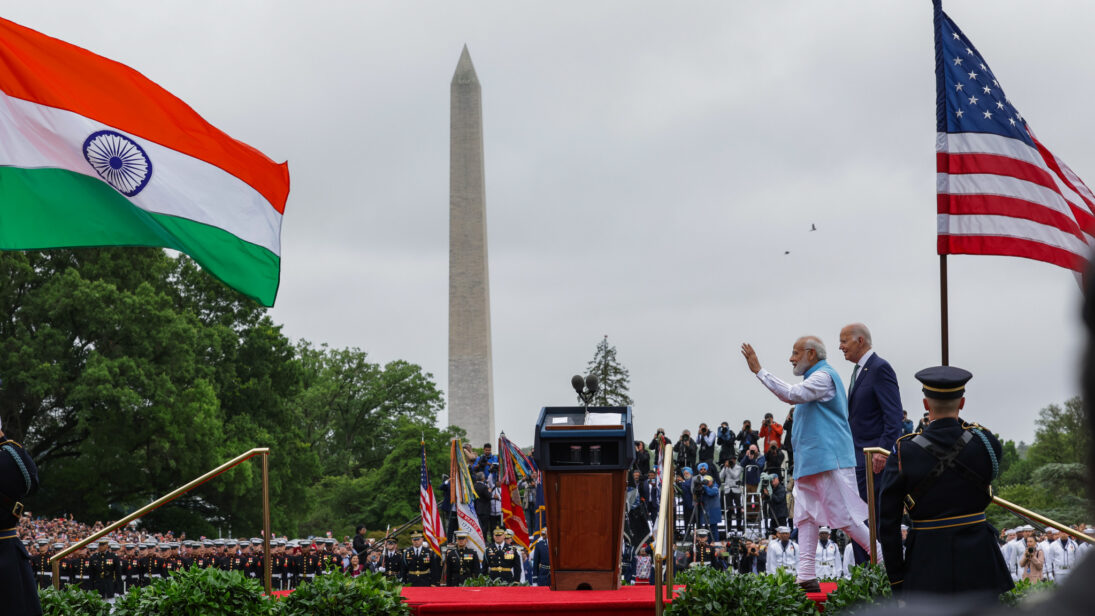
by Arvind Mohan
Since the middle of the 20th century, the United States has been an essential external power shaping the trajectory of South Asia. In the last decade, the priority of U.S. policy in the region has transitioned from concerns of an India-Pakistan war, the problems in Kashmir, and the worries of nuclear weapons proliferation to pushing back against Chinese military and economic influence and maintaining a favorable balance of power in the Indo-Pacific.
The Biden administration’s approach to South Asia continued and amplified the regional steps initiated under the Trump presidency. His leadership has impacted U.S. policy towards South Asia, subsumed within its Indo-Pacific strategy, in two fundamental ways: first, it has led to a broadly downward turn in the relationship with Pakistan and second, it has further deepened the strategic partnership with India. As South Asia develops into an important strategic theater for the great powers, these leitmotifs in U.S. regional policy are broadly expected to be continued by Biden’s successor.
U.S. Fallout with Pakistan
Pakistan was a prominent partner in the United States’ war on terror, but since President Joe Biden, in one of the most consequential foreign policy decisions of his term, ended the nearly two-decade-long war in Afghanistan, the U.S.-Pakistan relationship has deteriorated. Formerly warm ties turned sour as Washington accused Islamabad of supporting Taliban and providing the group sanctuaries in Pakistan. Moreover, as competition with big powers like China and Russia escalated, emphasis on Pakistan and Afghanistan as sites of securing U.S strategic interest dwindled. Therefore, following U.S. troop withdrawal from the region, the relationship with Pakistan narrowed in scope and revolved around Washington’s limited “over-the-horizon” counterterrorism operations in Afghanistan that rely on satellite technology and air power instead of personnel operating from the ground.
Biden chose not to establish any contact with Pakistan’s leadership for the first three years of his presidency, reflecting general U.S. indifference towards Pakistan. While Pakistan looked to improve its ties with the United States under its new geoeconomic strategy after the 2022 floods, the Biden administration did not offer anything substantial beyond maintaining old defense ties and piecemeal engagement. For Washington, the reduced geopolitical influence of Pakistan and its chronic political and economic crises potentially disincentivized the available scope for multi-sectoral engagement.
Washington’s reluctance to broaden the relationship unwittingly hastened Islamabad’s steady drift towards Beijing. Unsurprisingly, as per the China Index 2022, Pakistan topped the list of countries most influenced by China.
Strategic Convergence and Coordination with India
U.S. withdrawal from Afghanistan was guided by the understanding that the strategic competition to shape the 21st century will not be won or lost in the rugged mountains of the Hindu Kush but in the choppy waters of the Indo-Pacific. For Washington, South Asia has emerged as a theater for strategic competition with Beijing. To accommodate these new geopolitical realities, the Biden administration accelerated steps taken by his predecessors in prioritizing India instead of Pakistan as the lynchpin of Washington’s regional policy.

Indian policymakers have long aspired for the country to be the natural leader in South Asia – an idea fiercely contested by smaller powers in the region – and this view has found a strong ally in the Biden administration. While the United States has excluded Pakistan from its Indo-Pacific strategy, it labeled India as the most important partner in South Asia. India and the United States have acted in unison to support countries in the region against undue and coercive Chinese influence. For instance, New Delhi and Washington have tried to reduce Sri Lanka’s dependence on China and coordinated efforts on debt restructuring. Washington welcomed New Delhi undertaking a leadership role in stabilizing Colombo’s economic travails. At the height of the crisis, India provided nearly USD $4 billion in food and financial assistance to Sri Lanka. Indian aid was followed up by the United States, which offered USD $270 million. Sri Lanka’s envoy to India publicly acknowledged that economic aid from India was essential to the country availing itself of a bailout package from the International Monetary Fund. Another example of Washington-New Delhi coordination is when India welcomed the Maldives signing a defense cooperation agreement with the United States in 2020. Unlike in the past when India opposed security partnerships between the U.S. and smaller countries in the Indian Ocean, it considered Washington’s presence in the Indian Ocean in alignment with its own strategic interests.
India and the United States also elevated their bilateral relationship to a Comprehensive Global Strategic Partnership, growing defense relations and deepening trade and investment linkages. In a landmark agreement, the U.S.- India initiative on Critical and Emerging Technology (iCET) was a significant step designed to foster collaboration in the field of advanced technology like artificial intelligence, semiconductors, and biotechnology. Washington has also stated its willingness to bolster India’s military capabilities and both sides also conduct regular naval exercises to improve Indian Ocean maritime security. A strong structural logic undergirded by shared hostility to China has driven home the point in Washington that an economically and militarily adept India is in its self interest.
U.S. Future in South Asia
Historically, the U.S. relationship with Pakistan has been dominated by security issues with the economic partnership being subservient to strategic interests. It remains to be seen if the transition from a security oriented approach to a more comprehensive relationship can succeed. Especially now that they have fundamental strategic differences with regard to China and India, it will be a greater challenge to substantially improve economic ties.
Pakistan is also unlikely to receive any strategic concessions from the United States on affairs related to India. For instance, New Delhi’s handling of Kashmir has generated minor rebukes, but Washington has reiterated India’s stand that the issue has to be settled bilaterally with Pakistan without any third-party involvement. Moreover, while the United States continues to provide military packages to Pakistan, including the F-16s, it has deepened defense ties with India, contrary to the wishes of policymakers in Islamabad.
Disagreements between India and the United States can be expected on some regional issues in the future. For example, in Myanmar, the two countries might have differing policies. Washington, especially under a Democratic president, may increase support to the rebel forces, while India is likely to continue supporting the junta. However, the strategic convergence to ensure South Asia does not become a part of China’s sphere of influence will likely paper over other differences and ensure that the relationship is not derailed, irrespective of the political dispensation that comes to power in Washington.
While South Asia can expect broad continuity of U.S. policy under either a Harris or a Trump administration, their approach would be different on a few issues. The Harris administration, if it is staffed by the more progressive wing of the Democratic party, is much more likely to emphasize democracy and human rights as foreign policy values, which may lead to occasional criticism of countries in the region for curbing dissent or displaying religious majoritarianism. When forced to choose, strategic interests will likely override any ideological or value-based differences. A Trump presidency will give short shrift to any concerns about authoritarianism and discrimination in the region. Harris would also be predisposed to work alongside partners to achieve strategic goals. Trump has previously exhibited a more transactional approach in dealing with countries and, combined with his general disdain for multilateralism, will be less inclined to taking on board partners.
The U.S. relationships with other powers will also have repercussions for India and Pakistan. For instance, Trump may impose tighter sanctions on Iran and threaten countries with secondary sanctions for dealing with Tehran. This might prove to be a sticking point for both India and Pakistan, which would face more difficulties in maintaining their commercial relationship with Iran.
Trump would also take a more zero-sum approach to trade than Harris and may not shy away from imposing high tariffs on exports from even geopolitically friendly countries. For instance, Trump has previously threatened India with reciprocal tax, indicating that, like in his first-term, trade tensions may increase with India. Trump may also pressure Pakistan to limit its engagement with Chinese-led initiatives like the Belt and Road Initiative.
Ever since the U.S.-China détente in the 1970s, Asia has witnessed healthy cooperation between the two countries. However, over the past decade, the two countries have increasingly vied for greater geopolitical and geoeconomic influence at the expense of the other. While South Asia was often peripheral to the U.S. during the Cold War, the region can expect more sustained engagement from Washington as it embarks on an era of great power competition with Beijing.
source : southasianvoices
